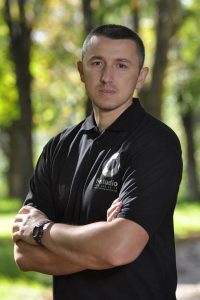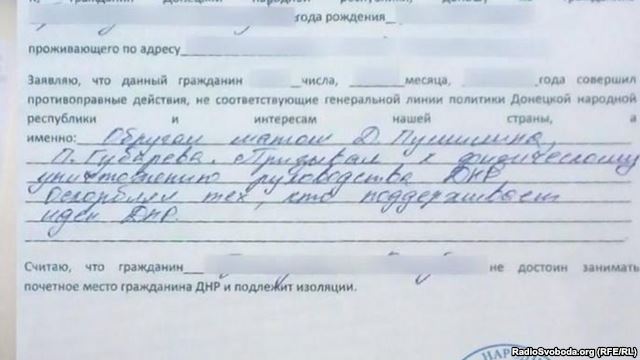After spending two years in the war zone, photographer Mykhailo Myhovych has created a series of artistic photos of soldiers fighting in the Donbas.
Mykhailo Myhovych’s project - Skhidny Forpost (Eastern Outpost) - was conceived to record and archive present military history and improve the army’s image. He sees the Ukrainian soldier as an image of the national ideal and believes that it is time to discuss publicly all the heroic actions performed by Ukrainian fighters.

- Mykhailo, your project consists of staged artistic photographs. They do not reflect the real war. Are these fighters really heroes?
First, the soldiers in these photos are members of the Azov regiment. I photographed them in between battles on the front line during their military exercises or at the Azov base in Urzuf. I tried to capture their deepest and truest emotions. Every man acted naturally. We worked for hours. The guys told their stories, talked about combat situations, became more open and more willing to be photographed. The photos came out very real and touching…
Secondly, I wanted the men in my photos to be real Heroes! I also focused on creating a positive image of the Ukrainian army; therefore the aim of my Eastern Outpost Project - a series of communicative photos and portraits of soldiers in the war zone – was to portray a collective image of the national hero. Through these photos, I’d like to evoke strong emotions and feelings in Ukrainians so that they will be proud of their army.

–
Something like Hollywood?
When we speak of “the American dream” or “the ideal policeman”, the successful businessman or the vamp, we understand that all these images have been created by Hollywood productions. It’s quite a good propaganda trick – they define our value system, our daily priorities, and to some extent, dictate what our behaviour should be. Similar artistic means are actively exploited by China, Israel, Japan and Europe. But what about Ukraine? Today, Ukraine has no image of a national hero. Moreover, neither the state nor civil society seems to understand the need for such a project. That’s why I’m funding this on my own. In fact, I had to sell my photo studio in order to reach the front lines.

- Doesn’t Ukrainian society want to see heroic actions?
Ukrainian society seems to cultivate the image of the “unfortunate” soldier. When our media show a battle scene, they usually opt for dramatic shots. This policy was adopted a year ago to recruit more volunteers and mobilize more human and material resources to help our army. Unfortunately, we all got stuck in this rut and it no longer works - people naturally try to distance themselves from a negative war, and they can’t and don’t want to feel psychologically oppressed. But, they aren’t offered an alternative image even though there are many positive things to say and show, and despite the fact that our army has become stronger and more developed.
Before going to the Donbas, I approached UNIAN and Reuters and offered them my services as a photographer. I was made to understand that I’d be limited due to their editorial policy – very little space is allowed for heroic actions and fighters. I had my own idea and a definite goal - to create a heroic image of Ukrainian men, defenders of our country and our state. Good, courageous, confident and well-trained soldiers that we can all rely on. I wanted these images to lift the spirit of Ukrainian people and create a positive image of Ukraine at the international level.

- Regardless of everything you say, what’s it really like? Wouldn’t it be better to say and show the truth?
Honestly, I don’t want to show real documentary photos that I took on the front. They don’t evoke a sense of pride. People believe pictures they actually see.
Today, the Ukrainian army is a cross section of Ukrainian society. Alongside soldiers who are under heavy fire, there are the usual drunkards, those who hide in dugouts or those looking for a quick deal. But, they are not the ones who can stop the enemy and they are not the ones who can change something. We want to see a strong army, just as we want to see a strong and decisive country, capable of protecting its citizens. This really depends on what kind of image our army portrays… but, at the moment, our army is undergoing many changes. In order to support these positive reforms, we need a positive image of our troops.

- Isn’t this just a lot of wishful thinking?
When I studied at the Catholic Institute of the Roman Catholic Church in Kyiv, my mentor was a Franciscan monk who never stopped repeating: “We need ideals.” For us, the younger generation, this meant spiritual ideals as exemplified by saints and mystics, and a closer relationship with God. Later, I realized that these ideals should be inherent in our nation’s relationship with God. When I speak of the nation, I’m not narrowing it down to a certain ethnicity as Ukrainian society is multi-ethnic. Similarly, the Ukrainian army is a poly-ethnic community of people who identify themselves as Ukrainian and bind their lives and future to Ukraine. I believe that such an army could become a symbol of the national ideal which should rally together all classes of society. I’d like the Eastern Outpost Project to become a chronicle of the Ukrainian army.

- A chronicle? So, does that mean texts will be added to the photographs?
To date, three other people from Ivano-Frankivsk have joined my project, and next year we plan to continue working in the war zone. We want to build a creative group that would work in three different areas - photography, video and texts. Each soldier has a personal story that’s worth recording. There is no pathos in these stories, but they are national treasures. These men and women are the soul of our nation. We haven’t realized it yet, but they’ll determine our future. Over time, their stories will be used to create national myths. Therefore, we want to preserve not only their faces, but also their voices, thoughts and emotions.
We’ve created a Facebook group where we’ll post all our materials. We’ll also show how our army and our defenders are portrayed in other countries… in order to build a feeling of respect for our soldiers.

- Today, your project involves exhibits and a calendar. At the opening of the exhibit in Ivano-Frankivsk, you announced that the exhibit would tour the country…
The initial idea of the project was international. My last personal exhibition was in Hungary – I’m an ethnic Hungarian; I was born in a Hungarian village in the Trans-Carpathian region, and so I had the opportunity to exhibit quite a lot abroad – but I was deeply hurt by the West’s arrogant attitude towards Ukrainians. When I spoke about the Donbas, I realized most Hungarians weren’t interested in the war in Ukraine. It’s the same in Germany and France; complete indifference – yeah, as long as we aren’t involved, they say – or a feeling of skepticism masked in irony – oh, yeah, it’s an internal war over there, a conflict between barbarians! When foreigners looked at my photos from the war zone, it was obvious they didn’t believe in Ukraine or its army. On the other hand, they respect the Russian army; they think Russia has a strong and powerful force and they fear it.
This attitude really upset me. So, I decided to launch the Eastern Outpost Project - a project that shows Ukraine has an army and that Ukraine is Europe’s eastern outpost. I want to take my photo exhibit to European cities where there is a Ukrainian Diaspora and show that Ukrainians are in the process of building their country, and this started with the army. That’s why we created this calendar so as to leave it in cities where the exhibit will be held as proof that a Ukrainian army actually exists.
I’d like to sell some calendars in order to continue this tour. Unfortunately, there are no funds to implement the project in this way. So, we decided on starting in Ukraine. I had my first photo exhibit in Ivano-Frankivsk where I got a lot of support from people willing to help organize further shows in other parts of the country.

- How did your family react to the project? Were they supportive?
I live in Ukraine, I don’t see myself living outside Ukraine and I want Ukraine to become a country where my loved ones can live comfortably. But, I’m not doing this only for myself, but for our common future. You may call me a romantic, but I have a reason - my family’s experience.
Each change of government in Ukraine took the life of men in my family. My grandfather’s brother on my mother’s side had to serve in the Soviet army when Transcarpathia was occupied by the Soviet Union. He died in Poland. My other grandfather was mobilized into the Hungarian army and fought on the German side in WW 2. He was also killed and rests somewhere in the vast fields of Europe. My grandmother’s brother was exiled to Vorkuta, Siberia because he served as commander in the UPA (Ukrainian Insurgent Army); he spent 12 years in the camps. My parents – both my mother and father – were liquidators at Chornobyl. My father died of cancer. All these turbulent historical events constitute a great personal experience for our generation. Therefore, such personal family experiences encourage each and every one of us to cultivate and build a unique “Ukrainian situation” in our country. My family was very understanding.

- How would you like Ukrainians to view the army?
We should change our social emphasis. Let me explain: today, Ukraine resembles a beheaded giant. And yet, the giant is alive - which is very strange – but, we don’t know what he’s doing or where he’s going. His head may be transplanted – it could be Georgian, Hungarian, American or something else. But, a Ukrainian “head” must be “grown”. The army is a cross section of our intellectual elite, but also the country’s iron fist. I’d like to see Ukrainians show respect to our soldiers and not to unscrupulous money-spinners, and I want our defenders, and not scheming moneybags, to become our national heroes! If we achieve this goal, we’ll be strong and free!





